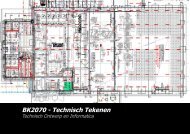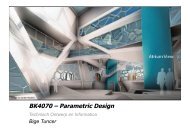Perception Aspects in Underground Spaces using ... - TOI - TU Delft
Perception Aspects in Underground Spaces using ... - TOI - TU Delft
Perception Aspects in Underground Spaces using ... - TOI - TU Delft
Create successful ePaper yourself
Turn your PDF publications into a flip-book with our unique Google optimized e-Paper software.
Figure 4: View over the platform. <strong>Underground</strong> metro station <strong>in</strong> Wash<strong>in</strong>gton DC, USAEscape (A 2 )If a person feels entrapped or <strong>in</strong>timidated by the presence of others, <strong>in</strong> order to avoid the situationthey may want to leave the space, or <strong>in</strong> other words, to escape. If there are any obstructions <strong>in</strong> thesurround<strong>in</strong>gs, which may h<strong>in</strong>der their attempt to escape, the feel<strong>in</strong>g of fear may arise (Korz,1998; Fisher and Nasar, 1992). It is <strong>in</strong>terest<strong>in</strong>g to note that there is a relation between anoverview and escape. Fisher and Nasar (1992, p. 61) showed that the “possibilities for escapetended to vary with prospect and when possibilities for the escape were low, fear of crime washigher”. This is further expla<strong>in</strong>ed through the fact that a good overview would provide apossibility to an <strong>in</strong>dividual to notice the eventual offender and act on time <strong>in</strong> order to avoid thesituation. Fisher and Nasar (1992, p. 40) def<strong>in</strong>e a degree to which a space affords opportunity forescape as “either an exit route from a potential threat, or a connection to others who couldrespond <strong>in</strong> case of an attack”. Hav<strong>in</strong>g this def<strong>in</strong>ition <strong>in</strong> m<strong>in</strong>d, the follow<strong>in</strong>g spatial aspects canhave a role <strong>in</strong> determ<strong>in</strong><strong>in</strong>g the degree for escape possibilities:•= Layout <strong>in</strong> sense of spatial organization but also related to the position<strong>in</strong>g of all elements thatcould obstruct the escape•= Clarity/spatial cont<strong>in</strong>uity – space should be easily understood so that it provides an<strong>in</strong>formation regard<strong>in</strong>g exits•= Accessibility – whether the escape routes are on the same or different level and whether theyare easy to f<strong>in</strong>d, or <strong>in</strong> other words, the perception by people that there are enough escaperoutes is important•= Adjacency – closeness of the exits from any given po<strong>in</strong>t <strong>in</strong> the stationVisibility/light (A 3 )This aspect may seem to be similar to the overview, but there is a difference. Under this aspectwe consider the light<strong>in</strong>g level upon which our ability to see is greatly dependent. Variousresearches have shown the relationship between the amount of light, the feel<strong>in</strong>g of public safetyand amount of crime (Van der Voordt and Van Wegen, 1987; Stollard, 1991; Korz, 1998; Galen,1999). In relation to crime, some research “suggests that 40% of night-time street crime occurs- 31 -





